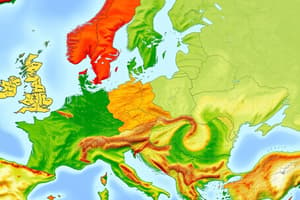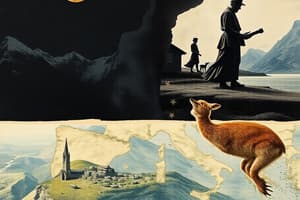Podcast
Questions and Answers
Which European climate region is characterized by hot, dry summers and mild, rainy winters?
Which European climate region is characterized by hot, dry summers and mild, rainy winters?
- Steppe
- Humid Continental
- Mediterranean (correct)
- Marine West Coast
The ongoing volcanic activity in Iceland, resulting in eruptions roughly every four years, is primarily a consequence of what geographic feature?
The ongoing volcanic activity in Iceland, resulting in eruptions roughly every four years, is primarily a consequence of what geographic feature?
- Its location within the Arctic climate region
- The meeting of the North American and Eurasian tectonic plates at the Mid-Atlantic Rift (correct)
- The Ural Mountains
- The abundance of glaciers
What is the primary geographic characteristic of the region south of Scandinavia and the United Kingdom?
What is the primary geographic characteristic of the region south of Scandinavia and the United Kingdom?
- Low-lying plains with low elevation (correct)
- High mountain ranges
- Extensive desert landscapes
- Active volcanic zones
Great Britain faces a significant geographic challenge due to its extensive coastline relative to its landmass. Which of the following is the most pressing issue arising from this?
Great Britain faces a significant geographic challenge due to its extensive coastline relative to its landmass. Which of the following is the most pressing issue arising from this?
Which mountain range is considered a boundary separating Europe from Asia?
Which mountain range is considered a boundary separating Europe from Asia?
The Scandinavian culture region is especially known for what?
The Scandinavian culture region is especially known for what?
The Basques are an distinct ethnic group primarily located in which region?
The Basques are an distinct ethnic group primarily located in which region?
The Romani people, known for their nomadic traditions, have origins in which region?
The Romani people, known for their nomadic traditions, have origins in which region?
The Sami people are indigenous to which region and traditionally practice what lifestyle?
The Sami people are indigenous to which region and traditionally practice what lifestyle?
What is the core principle behind universal healthcare?
What is the core principle behind universal healthcare?
The Treaty of Versailles, which concluded World War I, is considered to have contributed to the rise of World War II because:
The Treaty of Versailles, which concluded World War I, is considered to have contributed to the rise of World War II because:
Which of the following describes the policy of appeasement in the lead-up to World War II?
Which of the following describes the policy of appeasement in the lead-up to World War II?
What event is widely recognized as the start of World War II?
What event is widely recognized as the start of World War II?
What military strategy is Blitzkrieg most associated with?
What military strategy is Blitzkrieg most associated with?
What event led to Japan's surrender and the end of World War II in the Pacific?
What event led to Japan's surrender and the end of World War II in the Pacific?
What is the purpose of the European Union?
What is the purpose of the European Union?
How would you best describe a mixed economy?
How would you best describe a mixed economy?
What's an important export of Europe?
What's an important export of Europe?
Which of the following was a primary cause of World War I?
Which of the following was a primary cause of World War I?
Why is Germany known for its automotive industry?
Why is Germany known for its automotive industry?
Flashcards
Marine West Coast Climate
Marine West Coast Climate
Warm summers with cool, wet winters.
Steppe Climate
Steppe Climate
Semi-desert with occasional rain.
Arctic Climate
Arctic Climate
Short, cool summers, long, cold, snowy winters.
Humid Continental Climate
Humid Continental Climate
Signup and view all the flashcards
Mediterranean Climate
Mediterranean Climate
Signup and view all the flashcards
Mid-Atlantic Rift Effects in Iceland
Mid-Atlantic Rift Effects in Iceland
Signup and view all the flashcards
Physical Geography of Northern Europe
Physical Geography of Northern Europe
Signup and view all the flashcards
Dike
Dike
Signup and view all the flashcards
Erosion in Great Britain
Erosion in Great Britain
Signup and view all the flashcards
Europe and Asia border
Europe and Asia border
Signup and view all the flashcards
Mediterranean culture region
Mediterranean culture region
Signup and view all the flashcards
Scandinavia Culture
Scandinavia Culture
Signup and view all the flashcards
Alpine Culture Region
Alpine Culture Region
Signup and view all the flashcards
Baltic Culture Region
Baltic Culture Region
Signup and view all the flashcards
Basques Location
Basques Location
Signup and view all the flashcards
Romani culture
Romani culture
Signup and view all the flashcards
Sami People
Sami People
Signup and view all the flashcards
Universal Healthcare
Universal Healthcare
Signup and view all the flashcards
Islam growth
Islam growth
Signup and view all the flashcards
Purpose of the European Union
Purpose of the European Union
Signup and view all the flashcards
Study Notes
- Study notes pertaining to Europe
Geography
- Europe has five geographic climate regions:
- Marine West Coast: Warm summers and cool, wet winters.
- Steppe: Semi-desert with occasional rain.
- Arctic: Short, cool summers and long, cold, snowy winters.
- Humid Continental: Summers range from wet to hot, winters are cold and snowy.
- Mediterranean: Hot, dry summers and mild, rainy winters.
- The two tectonic plates that make up Iceland are the North American and Eurasian Plates.
- The Mid-Atlantic Rift causes volcanic eruptions roughly every 4 years in Iceland.
- Over 85% of housing in Iceland is heated by natural geothermal heat from hot springs.
- Meltwater from glaciers in Iceland provides hydroelectric power.
- Northern Europe, south of Scandinavia and the United Kingdom, consists of low-lying plains with low elevation.
- A dike is a defensive structure against flooding.
- One of the largest issues facing the geography of Great Britain is erosion because of the high ratio of shoreline to land on the continent.
- The Ural and Caucasus Mountains separate Europe from Asia.
Society and Culture
- The culture regions of Europe are:
- Mediterranean: Hot, dry summers and humid, cool winters.
- Scandinavia (Nordic Region): Known for a welfare system, pickled herring, and salted meats.
- Alpine: High elevations, spanning eight countries.
- Baltic: Located near a significant sea in Northern Europe, including Latvia, Estonia, and Lithuania.
- The Basques are an ethnic group located on the border of Spain and France near the Bay of Biscay and the western foothills of the Pyrenees Mountains.
- The Romani migrated from northern India to Eastern Europe in the 14th and 15th centuries and are traditionally nomadic, migrating seasonally along tribal links.
- The Sami are indigenous to Scandinavia and traditionally are nomadic reindeer herders.
- Universal Healthcare is where the population pays for healthcare as a society, intending to minimize overall expense and spread around cost and risk.
- Martin Luther started Protestantism.
- Islam has greatly increased in Europe because of conflict in North Africa, the Arabian Peninsula, and the Middle East.
- Germany is known for its automotive industry.
History
- Various reasons for WWI:
- Alliances
- Imperialism
- Militarism
- Nationalism
- WWI was characterized by trench warfare.
- New technologies that made trench warfare possible included tanks, machine guns, poisonous gas, and airplanes.
- The two powers in World War One were the Allied and Central Powers.
- The harsh terms of the Treaty of Versailles for Germany led to the rise of a dictator, contributing to World War II.
- Dictators who rose to power and their promises:
- Spain - Franko - freedom
- Italy - Mussolini - Economic recovery
- Germany - Hitler - To make Germany a great nation
- Japan - Tojo - Resources and power
- Russia - Stalin - Economic recovery
- Appeasement was the policy of Britain and France in the 1930s of making concessions to Nazi Germany, led by Adolf Hitler, in an attempt to avoid war.
- WWII started when Germany invaded Poland.
- The US entered the war after the attack on Pearl Harbor.
- Blitzkrieg, meaning "lightning war" is a series of quick and decisive short battles to deliver a knockout blow to an enemy state before it can fully mobilize.
- Island hopping was a US military strategy where Allied forces bypassed heavily fortified Japanese islands, focusing instead on capturing strategically important islands to establish bases for air and naval operations, gradually moving closer to Japan.
- The dropping of the nuclear bomb finally stopped Japan.
Politics and Economy
- The United Kingdom consists of Great Britain (England, Wales, and Scotland) and Northern Ireland.
- Founding governments of the Greeks and Romans:
- Greeks - Democracy: Known for creating city-states that collected taxes, raised armies, and wrote laws.
- Romans - Republic: Formed as an early Republic with Patricians and Plebeians.
- The purpose of the European Union is to ensure peace in Europe, create a high standard of living, ensure culture is respected, and maintain a strong economy.
- Types of economies:
- Mixed economy: Part market economy and part command economy.
- Market economy: Consumers and privately owned businesses determine supply.
- Command economy: Production, investment prices, and income are determined by the government.
- The largest major exports in Europe are machinery and/or motor vehicles/transportation equipment.
Studying That Suits You
Use AI to generate personalized quizzes and flashcards to suit your learning preferences.




